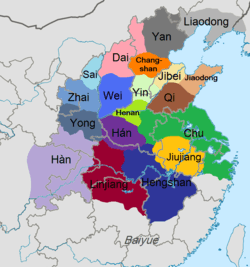Eighteen Kingdoms

The historiographical term "Eighteen Kingdoms" (十八国) refers to the eighteen feudal states created by Xiang Yu in China in 206 BCE, after the collapse of the Qin dynasty.[1] The details of the feudal division are as follows:
| Name | Name (Chinese) | Ruler | Areas covered (in present-day China) |
|---|---|---|---|
| Western Chu | 西楚 | Xiang Yu | Jiangsu, northern Anhui, northern Zhejiang, eastern and southern Henan |
| Hàn | 漢/汉 | Liu Bang | Sichuan, Chongqing, southern Shaanxi |
| Yong1 | 雍 | Zhang Han (Qin general) | central Shaanxi, and esten Gansu |
| Sai1 | 塞 | Sima Xin (Qin general) | northeastern Shaanxi |
| Zhai1 | 翟 | Dong Yi (Qin general) | northern Shaanxi |
| Hengshan | 衡山 | Wu Rui (Qin official supported by Yue tribes) | eastern Hubei, Jiangxi |
| Hán | 韓 | Han Cheng (Hán royalty) | southwestern Henan |
| Dai | 代 | Zhao Xie (Zhao royalty) | northern Shanxi, northwestern Hebei |
| Henan | 河南 | Shen Yang (Zhao official) | northwestern Henan |
| Changshan | 常山 | Zhang Er (Zhao vice chancellor) | central Hebei |
| Yin | 殷 | Sima Ang (Zhao general) | northern Henan, southern Hebei |
| Western Wei | 西魏 | Wei Bao (Wei royalty) | southern Shanxi |
| Jiujiang | 九江 | Ying Bu (Chu general) | central and southern Anhui |
| Linjiang | 臨江 | Gong Ao (Chu general) | western Hubei, northern Hunan |
| Yan | 燕 | Zang Tu (Yan general) | northern Hebei, Beijing, Tianjin |
| Liaodong | 遼東 | Han Guang (Yan royalty) | southern Liaoning |
| Qi2 | 齊 or 齐 | Tian Du (Qi general) | western and central Shandong |
| Jiaodong2 | 膠東 | Tian Fu (Qi royalty) | eastern Shandong |
| Jibei2 | 濟北 | Tian An (Qi rebel leader) | northern Shandong |
The Eighteen Kingdoms were short-lived: almost immediately rebellion broke out in Qi, after which Tian Rong conquered Jiaodong and Jibei, reuniting the old Qi state. Meanwhile, Xiang Yu had Emperor Yi of Chu and King Han Cheng of Hán killed. Thereafter, Liu Bang of Hàn conquered the lands of the Three Qins, thereby starting the Chu–Han Contention. Following many battles and changing alliances, Hàn defeated Chu and subdued all other kingdoms, where Liu Bang appointed vassal kings while making himself the first Emperor of the Hàn Dynasty in 202 BCE.
Notes
^1 Yong, Sai and Zhai were collectively known as the Three Qins because they occupied the area of the former Qin state, better known as Guanzhong.
^2 Jiaodong, Qi and Jibei were collectively known as the Three Qis because they occupied the area of the former Qi state.
References
- ↑ 林达礼,中华五千年大事记, 台南大孚书局, 1982, p56